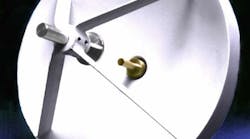This file type includes high-resolution graphics and schematics when applicable.
One application projected to move higher in frequency—radio-frequency-identification (RFID) tags—may fit numerous applications at millimeter-wave frequencies. First, though, compact RFID reader antennas with high axial ratios and fan-shaped radiation patterns need to be developed for use at frequencies between 57 and 64 GHz. In pursuit of such RFID antennas, a team from Monash University (Clayton, Australia) investigated the design of compact array antennas for use with chipless RFID tags.
The researchers considered the effects of different structural configurations as well as different substrate materials (including properties such as relative dielectric constant and substrate thickness) on the size and performance of various antenna designs with wide bandwidths at 60 GHz. Their candidate antennas were double-sided, printed-dipole (DSPD) antennas, which yielded wider bandwidths compared to the single-sided printed-dipole types
Commercial electromagnetic (EM) simulation software was used to refine the mechanical dimensions of the antennas and optimize performance prior to actually fabricating an antenna. In addition to the mechanical dimensions of the dipole antenna array, the design of the feeding network is critical to achieving the performance needed for the RFID reader application. It led to the development of a feedline extension using standard printed-circuit-board (PCB) substrate materials. See “Chipless RFID Reader,” IEEE Antennas & Propagation Magazine, October 2015, p. 18.
Looking for parts? Go to SourceESB.

